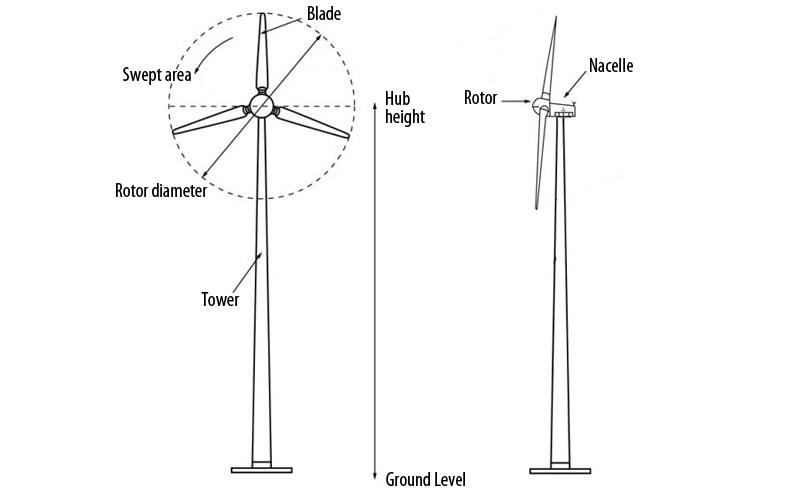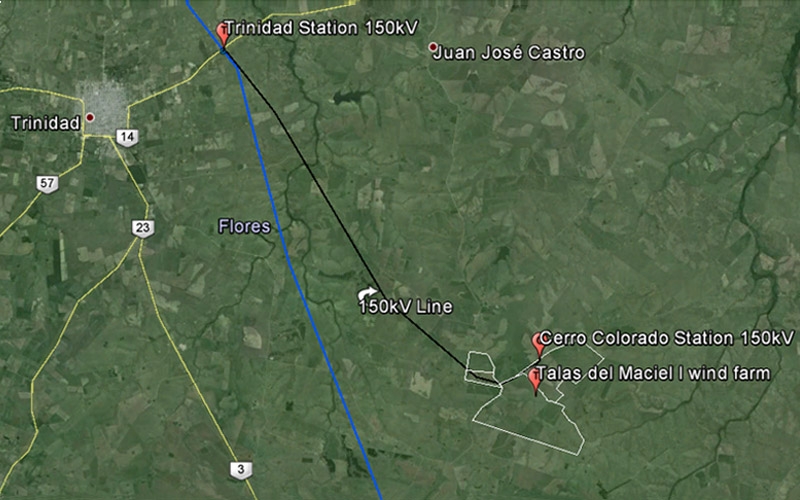Wind Farm
Site selection
The selection of this site was based on the wind speed and distribution information included in the wind map developed by the School of Engineering (Electrical Engineering Institute and Fluid Mechanics and Environmental Engineering Institute) along with the National Entity of Energy and Nuclear Technology from the Ministry of Industry, Energy and Mining. Once the site was selected and the leases agreed with the landowners, a wind measurement campaign began, in which the mean speed recorded speed was between 7m/s and 8m/s at 90m height. These values allowed choosing high performance equipment and evaluating the annual energy production within this background.
Site
Talas del Maciel I wind farm will be located in the rural zone of the department of Flores, in the center-east zone of the department, 18km southeast away from Trinidad city. The farm will occupy the rural plots 480, 481, 1995 and 4792 from the 6th Cadastral Section, which comprise a whole area of 1350has. The occupied areas will be as follows: 10has will be occupied by the roads, 5has by the assembly platforms, 2has by the internal substation and storage and 1ha by the foundations of the wind turbine generators. Only 3has from these latter will not be reachable by the landowners whereas the internal roads will be of common access.
The site can be reached either from National Highway Nr 3 at Cerro Colorado locality by travelling 15km North through local roads, or from National Highway Nr 14 at Juan José Castro locality by travelling 21km South.
Wind turbine generators
The wind turbine generators' model will be G97 of 2MW supplied by Gamesa. These are three bladed upwind rotor type with a nominal power of 2MW. This model has been certified by the International Electrotechnical Commission (IEC) as class IEC IIIA and was specially validated for the local conditions of the site.
Basically a wind turbine generator consists of three major components: nacelle, rotor and tower (see following figure). They will be painted in dull grey so that they do not reflect light.
The main characteristics of the wind turbines are indicated in the following table.
Characteristics of wind turbines |
|
Rotor diameter |
97m |
Swept area |
7.390m2 |
Blades length |
47,5m |
Hub height |
90m |
Minimum rotational speed |
9,6 rpm |
Maximum rotational speed |
17,8 rpm |
The generator will be asynchronous type and both speed gearbox and transformer are to be installed inside the nacelle.
The nacelle will adjust its orientation based on an automatic system that will use its own measured wind data. The blades will be able to adjust their angle as well. Both orientation system and blades angle allow the maximum use of the wind power, thus achieving optimal efficiency of energy production.
Each wind turbine will be supported on a 400m3 reinforced concrete base, of 18m diameter and variable height between 0,6m and 3m. The connection between tower and base will be achieved by the placement of a bar cage in the base to allow the assembly of the tower.
Assembly will be done by a high capacity crane (about 600Ton) beginning by the tower sections, afterwards the nacelle with the rotor already attached and finally the blades will be fixed to this latter.
Roads and platforms
The roads and the assembly platforms will be executed with compacted ballast to be extracted from quarries that will be opened within the plots of the farm.
The internal roads will be 6m wide with lateral ditches for drainage and storm sewers where necessary.
The rural access roads to the farm, mainly in the access from National Highway Nr 3, are to be adjusted on their closed curves, because of the length of the transportation trucks it is required to extend the turning radius in these cases.
The assembly platforms will allow the operation of the crane and the temporal storage of the components of the wind turbine generators.
Internal electric network
The wind turbine generators will generate between 600V and 700V power, which will be transformed to 30kV inside the nacelle. The wind turbine generators will be connected to the internal substation by means of 30kV switchgears and a buried cable network, where the cables (that will come from the four sectors if the farm) will be connected in the respective 30kV switchgears and then to the 30-150kV transformer. The connection to the National Interconnected System will be in 150kV where the measuring system of the electric power to be sold to UTE will be installed.
The following figure shows the wind turbines' layout, the 30kV network, the internal roads, the internal substation and UTE's connection substation.
Connection network to the National Interconnected System
The farm will be connected to UTE's transmission network (National Interconnected System) by a 150kV substation to be built next to the internal substation, named Cerro Colorado Station. Moreover this latter will be connected to UTE's existent substation, named Trinidad Station, by a double circuit 150kV line to be built.
The construction of Cerro Colorado Station, the construction of the 150kV line and the extension works on Trinidad Station will be borne by the wind farms that will make use of these facilities, that includes Talas del Maciel I. Notwithstanding the abovementioned, these facilities will be property of UTE once the works are finalized and accepted, who will operate them as part of the National Interconnected System.
Operation and maintenance of the farm
The maintenance of the wind turbine generators will be done by a subsidiary of the manufacturer, so as to ensure maximum availability and durability of the equipment.
The maintenance of the internal network and substation of the farm will be done by specialized staff of ASITDEY.
All the equipment including the wind turbines, the internal network and substation will be monitored the 24 hours and 365 days a year, by supervisory control and data acquisition systems. Additionally there will be specialized personnel attending the facilities during normal business hours and at any time upon request, for the purpose of carrying out the planned reviews and any necessary repairs.
The coordination for the operation of the farm with UTE's operation central will be done by staff designated by ASTIDEY.








